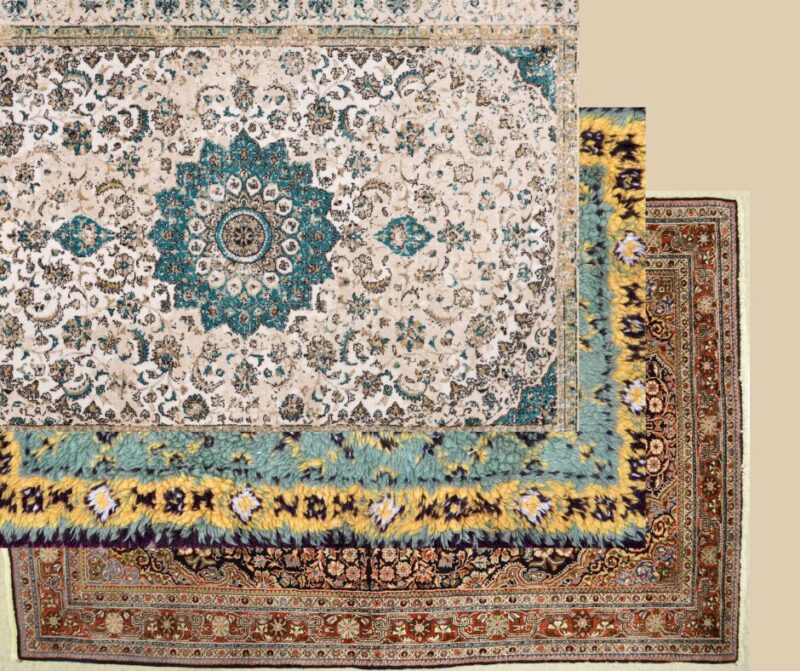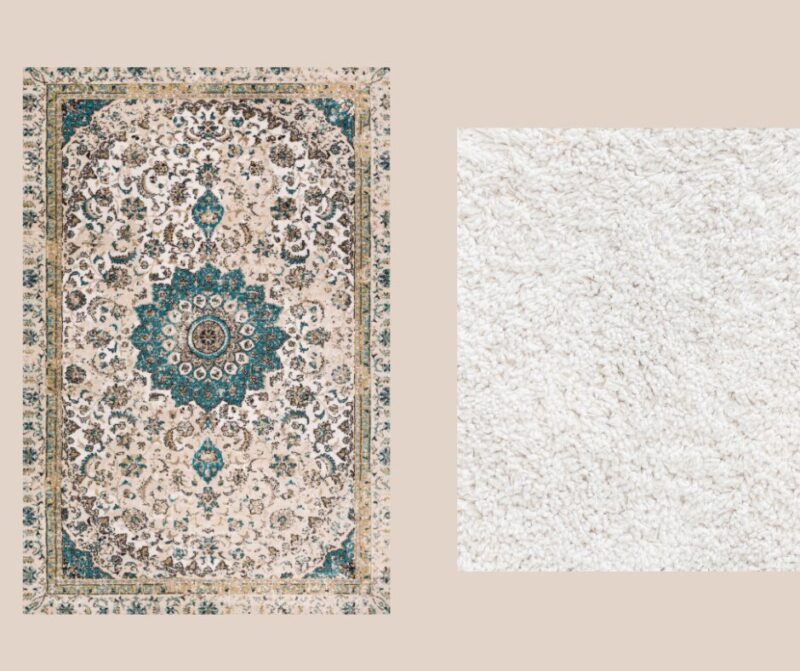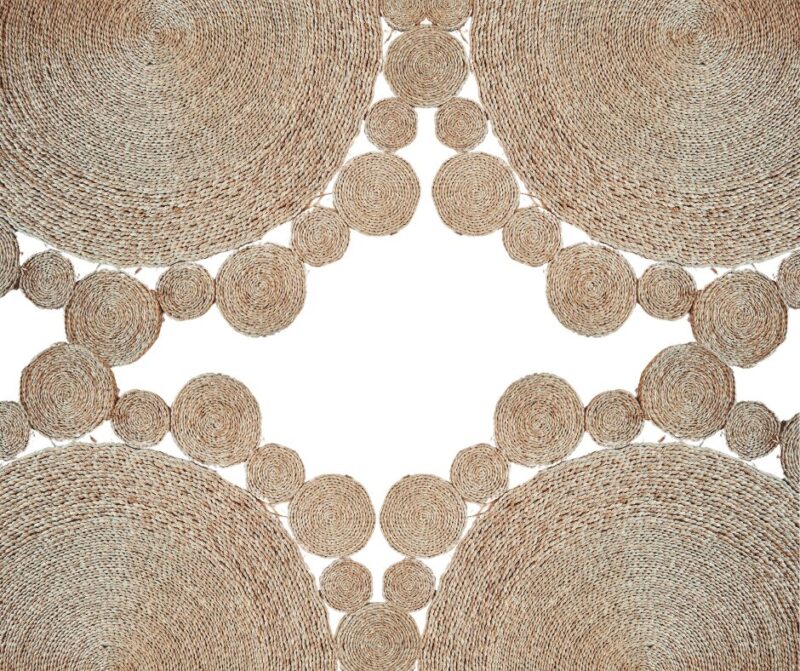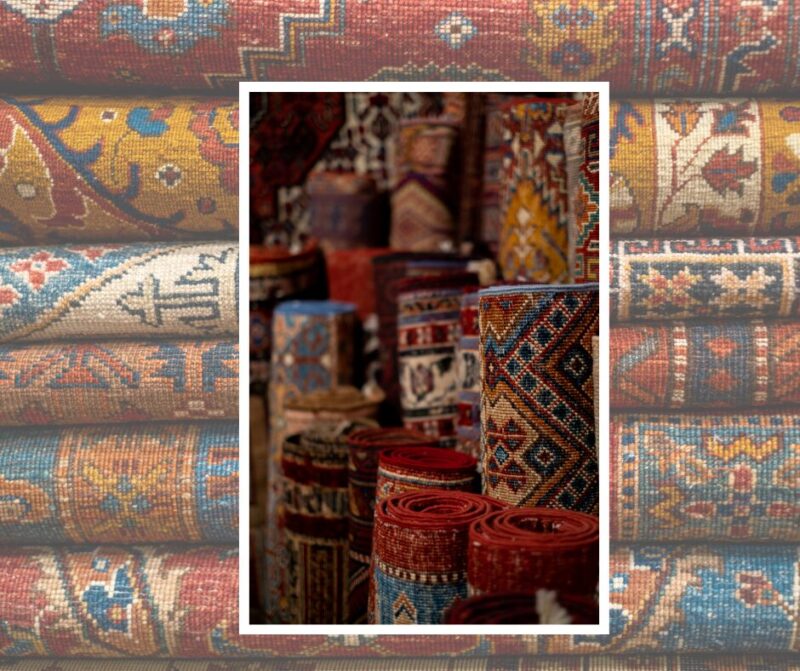Area rugs can add the perfect finishing touch to a room’s design and style.
The right rug can tie the room together, uniting furniture and decor while highlighting subtle colors.
However, area rugs offer more than just aesthetic appeal:
- They can define distinct spaces in your home
- Protect beautiful wood floors
- Provide sound absorption.
Plus, who doesn’t enjoy sinking their toes into a plush rug? All of these benefits combine to create a more comfortable, stylish, and personalized home.
When selecting a rug, there are several important factors to consider ensuring it meets your needs and complements your space.
What Room is the Rug For?

The purpose and location of the rug within your home greatly influence your choice.
Rugs for living rooms, bedrooms, dining areas, and entryways each have unique requirements.
For example, a living room rug often serves as a focal point, tying together furniture and decor, while a bedroom rug adds comfort underfoot.
Is it a High Traffic Area?
Consider the amount of foot traffic the area receives. High-traffic areas like hallways, entryways, and family rooms require durable rugs that can withstand frequent use.
Low-pile or flat-weave rugs are excellent choices for these spaces as they are easier to clean and maintain.
Do You Have Pets or Children in This Area?

If you have pets or children, select a rug that is stain-resistant and easy to clean.
Materials like wool or synthetic fibers are durable and can handle spills and accidents better than delicate materials.
Additionally, consider patterns and colors that can camouflage stains and wear.
Will You Be Eating in This Area?
For dining areas, opt for rugs that are easy to clean and can handle food and drink spills.
Low-pile rugs or those made from synthetic fibers can be easily spot-cleaned and are less likely to trap crumbs and debris.
Do You Have Furniture Picked Out for This Area?

Ensure the rug complements your existing furniture. Measure both your room and furniture before deciding on the rug size.
The rug should be large enough to hold the furniture in place and keep it from sliding.
For dining areas, the rug should extend beyond the edges of the table to accommodate chairs being pulled out.
Tips for Caring for Your Rug
Proper care and maintenance can extend the life of your rug and keep it looking fresh and beautiful.
Rotate Your Rug Once a Year
Rotating your rug annually helps distribute wear evenly, preventing one area from becoming more worn than others.
This is especially important in high-traffic areas to maintain the rug’s appearance and longevity.
Vacuum Your Rug with Care
Vacuuming is essential to keep your rug clean, but it must be done correctly.
Ensure your vacuum is set to the appropriate height for your rug type to avoid damaging the fibers.
Use a gentle suction setting and avoid using the beater bar on delicate rugs.
Use a Rug Pad to Help with Durability
A rug pad provides additional cushioning, prevents slipping, and reduces wear on the rug.
It also allows for better air circulation, which can help prevent moisture buildup and extend the rug’s life.
Common Rug Layouts
Now let us address the common layouts in different parts of the house.
Entryways and Hallways
Rug runners are ideal for entryways and hallways due to their length and narrow width.
They protect the floor from heavy foot traffic, add personality, and can make narrow spaces feel more welcoming.
Runners also work well in seating areas, providing comfort and a touch of style.
The Living Room
| Living Room Rug Layout | Description | Recommended Rug Sizes |
|---|---|---|
| All Legs On | All furniture legs on the rug for a cohesive look, making the room feel larger. | 9′ x 12′, 11′ x 14′ |
| Two On, Two Off | Front legs on the rug, back legs off for a balanced look. | 6′ x 9′, 8′ x 10′ |
| All Legs Off | Rug in front of furniture, ideal for highlighting a coffee table. | 4′ x 6′, 5′ x 7′ |
The Bedroom
| Room | Rug Size | Purpose |
|---|---|---|
| Bedroom | 8′ x 10′ (Queen Bed) | Adds warmth and frames the bed. |
| 9′ x 12′ (King Bed) | ||
| Dining Room | 8′ x 10′ | Extends beyond table, accommodates chairs, and protects floor. |
| 9′ x 12′ |
Common Rug Shapes
| Rug Shape | Description |
|---|---|
| Runner | Ideal for narrow spaces like entryways or hallways. |
| Rectangle | Versatile for living, family, and dining rooms. |
| Square | Suits square furniture arrangements and dining tables. |
| Oval | Complements rectangular and oval dining tables. |
| Round | Great for entryways, hallways, and seating areas. |
| Octagon | Unique for dining rooms with round or octagonal tables. |
Types of Rug Construction
| Type of Rug Construction | Description |
|---|---|
| Woven Rugs | Durable, various materials, ideal for high-traffic. |
| Braided Rugs | Reversible, mat-like, adds rustic charm. |
| Knotted Rugs | High quality, heirloom durability, intricate designs. |
| Loomed Rugs | Consistent quality, lower price, synthetic, stain-resistant. |
| Hooked Rugs | Textured feel, less shedding, cozy look. |
| Tufted Rugs | Budget-friendly, plush, may shed. |
Rug Materials
| Rug Material | Description |
|---|---|
| Wool | Durable, affordable, naturally stain-resistant, insulates cold floors, soft feel, may shed. |
| Natural Fibers | Eco-friendly, affordable, made from jute, sisal, bamboo, or seagrass, adds an earthy touch. |
| Leather | Smooth, durable, stain-resistant, rustic vibe, easy to clean, unique texture. |
| Synthetic | Stylish, low-cost alternative to natural fibers, easy to care for, won’t fade, less luxurious. |
| Silk | Luxurious, expensive, soft with sheen, perfect for bedrooms, sensitive to moisture. |
| Cotton | Low maintenance, easy to clean, less likely to shed, versatile, easily dyed. |

